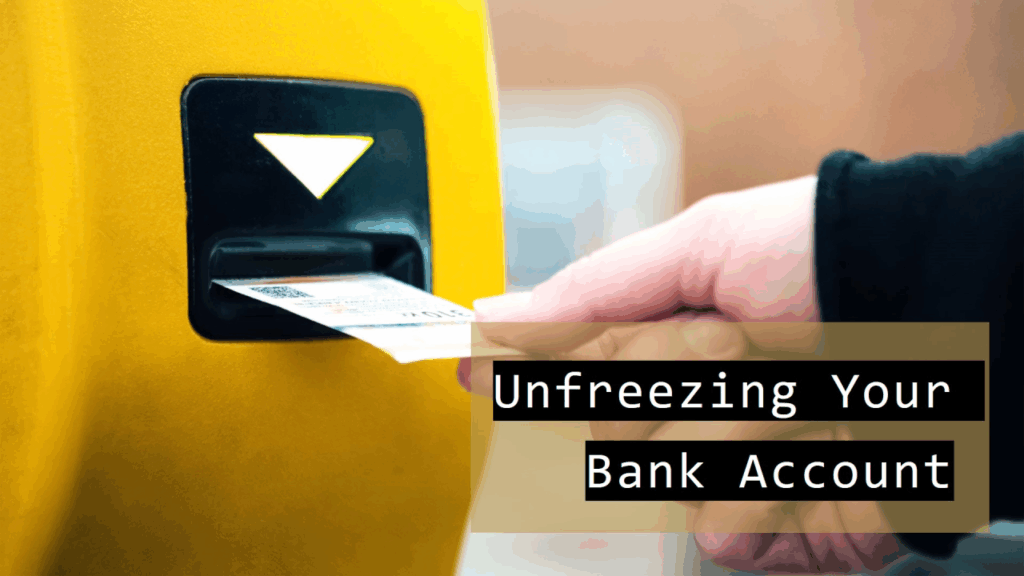Bank Account Unfreeze – Complete Step-by-Step Guide
If your bank account is frozen, you don’t have to panic. Top Legal Help provides expert guidance to help you regain access to your funds quickly. Whether your account is frozen due to court orders, tax issues, loan defaults, suspicious transactions, or KYC problems, we show you exactly how to act.

Why Your Bank Account Gets Frozen
A frozen bank account can disrupt your financial life. Understanding the reason helps you act correctly and regain access efficiently. Common causes include:
1. Legal Issues
Court orders, tax notices, or pending legal cases can lead banks to freeze accounts immediately. Acting quickly with legal guidance ensures you comply and restore access.
2. Suspicious Transactions
Banks monitor accounts for unusual deposits, sudden withdrawals, or irregular activity. If a transaction seems suspicious, the bank may temporarily freeze your account to prevent fraud or money laundering.
3. Overdue Loans or EMIs
If you default on loans or EMIs linked to your account, banks may restrict access until you clear the dues. Regularly tracking repayments prevents unnecessary freezes.
4. KYC/Account Verification Issues
Incomplete, outdated, or missing Know Your Customer (KYC) documents can trigger account freezes. Updating your KYC ensures smooth banking operations.
5. Government or Regulatory Action
Authorities may freeze accounts involved in fraud, money laundering, or other regulatory issues. Complying promptly with directives helps release the freeze faster.
How to Unfreeze Your Bank Account – Step by Step
Follow these steps to restore full access to your account:
Step 1: Identify the Reason
Check SMS alerts, emails, or bank notifications.
Visit your bank branch to confirm why your account is frozen.
Understanding the exact reason helps you prepare the right documents.
Step 2: Gather Required Documents
Updated KYC documents (Aadhar, PAN, Passport).
Court orders or legal clearances for freezes due to legal action.
Loan repayment receipts, debt settlement letters, or proof of cleared dues.
Bank statements or evidence proving legitimate transactions.
Step 3: Submit a Bank Unfreeze Request
Write a formal application requesting account unfreeze.
Attach all supporting documents and identification proofs.
Keep copies of all submissions for your records.
Step 4: Follow Up Regularly
Banks usually process unfreeze requests within 1–7 working days.
Contact the branch if you notice delays.
Escalate to the bank manager if processing exceeds standard timelines.
Step 5: Use Digital Banking Options
Many banks allow unfreeze requests via net banking or mobile apps.
Navigate to sections like “Support” or “Service Requests.”
Upload scanned documents digitally for faster processing.
Tips to Prevent Future Account Freezing
Keep your KYC documents updated at all times.
Avoid large or suspicious deposits without notifying the bank.
Pay EMIs, loans, or dues promptly to avoid freezes.
Inform the bank if you anticipate large transactions.
Monitor your account activity regularly for irregularities.
Maintain documentation for all major transactions to avoid disputes.
Q1: How long does it take to unfreeze a bank account?
Typically, banks process unfreeze requests within 1–7 working days. Complex legal cases may take longer.
Q2: Can I access my account partially during a freeze?
Yes. Some banks allow limited withdrawals or transactions under a certain limit.
Q3: Can legal action continue while my account is frozen?
Yes. A freeze restricts transactions but does not prevent legal proceedings. Compliance with authorities remains necessary.
Q4: What if the bank delays unfreezing?
Escalate to the branch manager, submit a formal complaint, or approach the banking ombudsman.
Q5: Can I prevent account freezing in the future?
Yes. Maintaining updated KYC, monitoring transactions, and settling dues on time significantly reduces the risk of freezing.
Additional Resources and Support
Legal Advice for Bank Issues: Consult our experts for personalized solutions.
Online Unfreeze Requests: Use net banking or mobile apps to submit documents digitally.
Banking Ombudsman: File a complaint if your unfreeze request faces unnecessary delays.
Conclusion – Fast Bank Account Unfreeze
A frozen bank account can disrupt daily life, but you can resolve it efficiently. Keep KYC documents updated, monitor all transactions, and settle pending dues promptly. Following the correct steps ensures a smooth and quick bank account unfreeze.
Take action today with the right guidance and restore access to your account safely.
Need Help With Bank Account Unfreeze? Contact Us Today!




